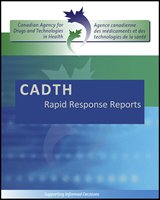Dexmedetomidine for Sedation in the ICU or PICU: A Review of Cost-Effectiveness and Guidelines
Rapid Response Report: Summary with Critical Appraisal
Sedation of ICU patients is often essential for ICU patients to maximize survival, reduce ICU and hospital stay, and facilitate mechanical ventilation. The standard of care for sedation includes benzodiazepine sedatives and propofol. These sedatives (notably benzodiazepines) are associated with an increased risk of agitation and delirium. It has been hypothesized that dexmedetomidine would be an appropriate alternative to traditional sedatives for maintaining light to moderate sedation. Dexmedetomidine is an alpha2-adrenergic agonist, and it is approved in Canada for intensive care unit sedation and conscious sedation. In January 2014, the Canadian Agency for Drugs and Technologies in Health (CADTH) reviewed the evidence on the clinical effectiveness of using dexmedetomidine for sedation in intensive-care unit. Based on the CADTH review, dexmedetomidine was found to be associated with decreased ICU stay and decreased time on mechanical ventilation. However, it was associated with higher rates of bradycardia than comparators.
Dexmedetomidine is available in 100 mcg/mL in a 2 mL glass vials at $45.21 per vial. At the maximum allowed daily dose, dexmedetomidine is more expensive than midazolam, lorazepam, and propofol (Appendix 1). However, it is not clear if the higher cost of dexmedetomidine is offset by its suggested benefits. The objective of this report is to review the cost-effectiveness and the available evidence-based guidelines for using dexmedetomidine for sedation the intensive care unit.
Disclaimer: The Rapid Response Service is an information service for those involved in planning and providing health care in Canada. Rapid responses are based on a limited literature search and are not comprehensive, systematic reviews. The intent is to provide a list of sources of the best evidence on the topic that CADTH could identify using all reasonable efforts within the time allowed. Rapid responses should be considered along with other types of information and health care considerations. The information included in this response is not intended to replace professional medical advice, nor should it be construed as a recommendation for or against the use of a particular health technology. Readers are also cautioned that a lack of good quality evidence does not necessarily mean a lack of effectiveness particularly in the case of new and emerging health technologies, for which little information can be found, but which may in future prove to be effective. While CADTH has taken care in the preparation of the report to ensure that its contents are accurate, complete and up to date, CADTH does not make any guarantee to that effect. CADTH is not liable for any loss or damages resulting from use of the information in the report.
Copyright: This report contains CADTH copyright material and may contain material in which a third party owns copyright. This report may be used for the purposes of research or private study only. It may not be copied, posted on a web site, redistributed by email or stored on an electronic system without the prior written permission of CADTH or applicable copyright owner.
Links: This report may contain links to other information available on the websites of third parties on the Internet. CADTH does not have control over the content of such sites. Use of third party sites is governed by the owners’ own terms and conditions.
Except where otherwise noted, this work is distributed under the terms of a Creative Commons Attribution-NonCommercial- NoDerivatives 4.0 International licence (CC BY-NC-ND), a copy of which is available at http://creativecommons.org/licenses/by-nc-nd/4.0/
